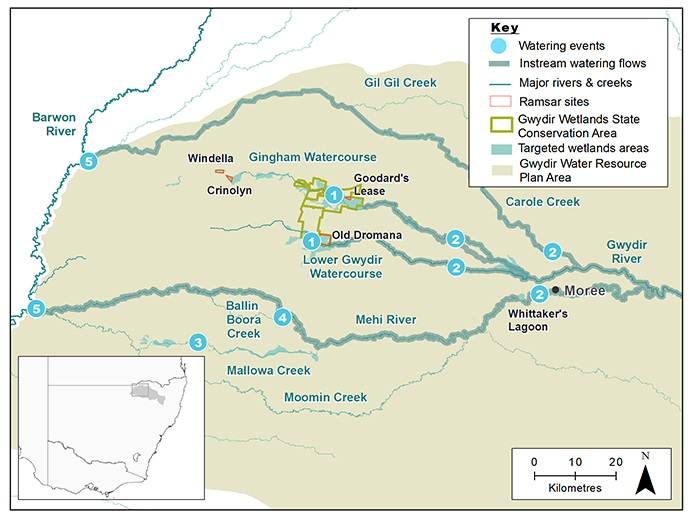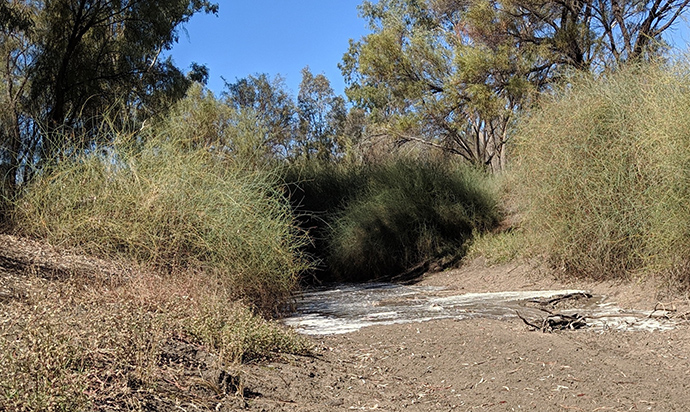The Gwydir River system and its wetlands are located on a semi-arid floodplain, in a relatively low rainfall zone. This influences decision-making around water for the environment.
Since the summer of 2016, the Gwydir catchment has experienced an extended dry period. The 2018–19 water year was hot and dry with limited rainfall and low natural flows. Water for the environment was used to support rivers and wetlands through this dry phase.
A conservative planning approach taken over preceding seasons meant that reasonable reserves of water for the environment were available at the beginning of the 2018–19 water year.

Map of the Gwydir catchment showing waterways, wetlands and locations of water for the environment deliveries made in 2017–18.
Watering aims
In the 2018–19 year,rainfall and natural river flows were low; however reserves of water for the environment were available to preserve targeted water-reliant ecological communities and support them through this dry phase.
The Department of Planning, Industry and Environment – Environment, Energy and Science’s (DPIE–EES) Water for the Environment Team worked with the Commonwealth Environmental Water Holder to manage 114.2 gigalitres of water flows to:
- support and preserve the health of priority aquatic environments
- conduct a small watering trial in the Ballin Bora Creek
- provide water to wetland vegetation and dependent fauna in the Gingham and Lower Gwydir wetlands
- provide water to wetland vegetation and dependent fauna in the Mallowa Creek and wetlands
- provide substantial water for the Northern Fish Flow into the Barwon–Darling River and to Brewarrina Weir pool.
Annual planning of water for the environment takes a flexible and responsive approach. This approach responds to natural cues and ecological water needs across the range of systems and climatic conditions. Annual planning has a rolling 3-year planning cycle and considerations include carrying over sufficient volumes to support water-dependent communities in the longer term.
Water delivery
This table provides a summary of environmental water delivered in the Gwydir catchment during the 2018–19 watering year. Volumes are indicative only.
Notes: Location numbers in the table relate to water events marked on the map. NSW = NSW licensed environmental water; CEW = Commonwealth licensed environmental water; EWA = Environmental water allowance accrued under the Water Sharing Plan for the Gwydir Regulated River Water Source 2016; * indicates this event was managed by the Commonwealth Environmental Water Holder with support from the Department of Planning, industry and Environment and delivered through CEW.
| Watering event number | Location | Start date | Finish date | NSW | CEW | EWA | Total |
|---|---|---|---|---|---|---|---|
| 1 | Gingham and Lower Gwydir Wetlands | 17 Jul 2018 | 7 Feb 2019 | – | 30,000 | 30,000 | 60,000 |
| 2 | Dry river protection: Gwydir and Mehi Rivers & Carole Creek | 6 Sep 2018 | 16 Sep 2018 | – | 4000 | 4000 | 8,000 |
| 3 | CEWH Mallowa Creek and Wetlands | 30 Nov 2018 | 14 Feb 2019 | – | *16,950 | – | *16,950 |
| 4 | Ballin Bora Creek | 10 Dec 2018 | 1 Feb 2019 | – | 600 | – | 600 |
| 5 | Connection of Northern Fish Flow to Barwon–Darling system | 17 Apr 2019 | 8 Jul 2019 | – | 10,600 | 18,000 | 28,600 |
| Region | Total |
|---|---|
| NSW | - |
| CEW | 62,150 |
| EWA | 52,000 |
| Total | 114,150 |
Outcomes
During the 2018–19 water year, water for the environment was released into the Gwydir Wetlands systems and Mallowa Creek watercourse. Water was also used to protect priority river reaches in the Carole Creek, Mehi and Gwydir rivers from complete drying. A small watering trial was conducted in Ballin Bora Creek, an anabranch of the Mehi River.
Gwydir Wetlands systems
A total of 60 gigalitres of water was delivered to the wetlands of the Lower Gwydir and Gingham watercourses. This watering aimed to preserve wetland condition in preparation for the forecast dry conditions. Almost 4000 hectares were inundated in the Gingham section and just over 3000 hectares in the Lower Gwydir section.
Surveys conducted in these areas reported:
- widespread growth of flow-dependent vegetation, including at sites not inundated for some time
- limited presence of the exotic lippia weed
- provision of habitat for many waterbird species during an extended dry period across the Murray–Darling Basin
- sightings of nationally endangered Australasian bitterns, 5 internationally recognised migratory bird species and 6 species listed in NSW Biodiversity Conservation Act 2016
- widespread recruitment of a range of flow-responsive frog species (from surveys in September and November 2018).
Four deliveries of water for the environment targeted pools in river reaches that had ceased to flow. Releases in:
- September 2018 provided water to pools in the Mehi River
- October 2018 targeted Carole Creek
- April 2019 supported the Mehi River and Carole Creek
- May 2019 benefited the Gwydir River.
The intent of these releases was to maintain water quality and water levels in pools. This would enable fish to move between pools and reduce the risk of fish kills from the drying river. No fish kills were reported in the Gwydir in 2018–19.
Mallowa Creek watercourse
Water delivery to the Mallowa Creek inundated about 2000 hectares of wetland and floodplain, enabling reconnection with the Moomin Creek.
Surveys of inundated areas found the water release:
- provided habitat for many waterbird species, with sightings of 3 internationally recognised migratory bird species and 4 species listed in NSW Biodiversity Conservation Act 2016
- positive responses from vegetation and key habitats
- benefited a range of frog species and supported widespread successful breeding outcomes, particularly for flow-responsive frog species.
Ballin Bora Creek watering trial
A trial watering of the Ballin Bora Creek via upstream private irrigation infrastructure was conducted from December 2018 to January 2019. Stock and domestic water was previously delivered this way, but this was the first-time managers of water for the environment worked with the landholder to deliver flows to the system to improve habitat in the stream. Water was delivered in two flows:
- A release of 388 megalitres, connected 28 kilometres of Ballin Bora Creek to the Mehi River, over 6 days.
- A delivery of 200 megalitres did not make the expected connection to the Mehi River, only reaching and filling ‘Coolibah’ crossing pool.
Delivery of water to Ballin Bora Creek topped-up waterholes, and supported water-dependent species including Latham’s snipe, turtles, several frog species and plants.
A flow was also delivered into the Mehi River to connect the Gwydir system with the Barwon River. More detail on this release is provided in the case study.
Case study: The Northern Fish Flow
Water releases achieved significant outcomes for the Gwydir catchment and downstream communities in 2018–19.
The Gwydir Environmental Water Advisory Group endorsed a release of 28.6 gigalitres of water for the environment from Copeton Dam as part of the Northern Fish Flow event. New South Wales contributed 18 gigalitres and the Commonwealth Environmental Water Holder (CEWH) provided 10.6 gigalitres.
Survival of native fish was one of the main objectives of the Northern Fish Flow event. The flow refilled and reconnected refuge pools along the Mehi and Barwon rivers.
At the same time, 7.4 gigalitres of CEWH water was released from Glenlyon Dam (just north of the Queensland border), with the aim of meeting the Gwydir/Mehi (Copeton Dam) release as it flowed into the Barwon River.
The Glenlyon release fell just short of its target (at the junction of the Mehi and Barwon rivers) because of dry conditions, but the Gwydir/Mehi flow continued downstream and filled the Collarenebri, Walgett and Brewarrina weir pools. The flow eventually ceased just short of the junction of the Culgoa and Barwon rivers.
In the Gwydir catchment, the event:
- boosted available habitat and food for native fish
- gave fish the opportunity to move within the river system
- provided important social and cultural outcomes for communities in the Gwydir catchment and further downstream was met with relief and excitement by local communities.

Northern Fish Flow arriving at the Mehi River, Gwydir catchment, 2018–19